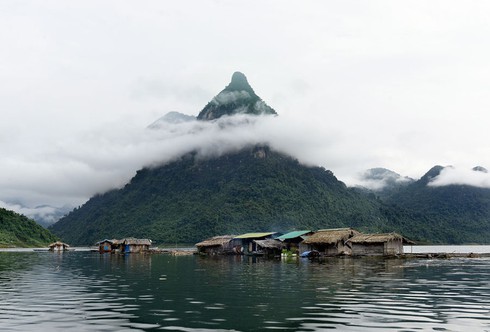
110 kilometers from Tuyen Quang city, the Na Hang eco-tourism area has emerged as a tourist destination popular for its unspoiled beauty and unique ethnic culture.
110 kilometers from Tuyen Quang city, the Na Hang eco-tourism area has emerged as a tourist destination popular for its unspoiled beauty and unique ethnic culture.
 |
| Na Hang lake (Photo: baobackan.org.vn) |
The Na Hang eco-tourism area stretches over 15,000 hectares, more than half of which is water. The Na Hang–Lam Binh reservoir, which connects with Ba Be National Park, is the biggest reservoir in Vietnam’s northern region.
Nguyen Viet, a Tuyen Quang resident, said, “My family and I often travel to Na Hang for weekends or national holidays. I sometimes bring friends from Hanoi, Hai Phong, Ho Chi Minh City, and Can Tho here. They are always impressed by the local landscape, people, and culture .”
Na Hang lake, the gem of the eco-tourism area, has been dubbed the ‘Ha Long Bay of the hills’. 99 mountains of exotic shape cast their shadows on the lake’s calm, emerald water.
Boats now take visitors on 70-kilometer discovery tours of Na Hang lake where they learn about the area’s history while enjoying the spectacular landscape.
The prime destination here is the Na Hang natural reserve, a habitat of thousand-year-old trees and rare fauna, including the Tonkin snub-nosed langur, a species listed in the Red Book of the International Union for Conservation of Nature (IUCN).
Do Thu Hang, a Hanoi tourist, said, “I’m really enjoying my trip here. Na Hang boasts tranquility, clean air, emerald water, and strangely-shaped mountains which turn blue behind the clouds. I most love following the streams, where I enjoy foot massages by the little fish. I believe many other visitors share my interest in Na Hang.”
12 ethnic groups live in Na Hang. Their diverse cultures add excitement to trips to Na Hang. Visitors are attracted to the local singing genres - the “Then” and “Luon” songs of the Tay, the “Sli” songs of the Nung, and the “Soong Co” songs of the San Diu.
Plan your trip to coincide with one of the local traditional festivals, such as the Tay or Nung “going to the field” ritual, or a Dao wedding or maturity ritual. The Thuong Lam mountain market, opens every Thursday and Sunday, is another worthwhile Na Hang attraction.
When it comes to food, Na Hang has a lot to offer: stream fish, ducks, special vegetables, and wine distilled from leaves.
Local people have recently begun to offer homestay services. Trieu Van Doi, a homestay host, said, “I upgraded my stilt house a year ago to open a homestay service. I really hope more visitors will learn about and come visit Na Hang.”
The once arduous road into Na Hang has been improved. Now more accessible, Na Hang is welcoming growing numbers of tourists.





